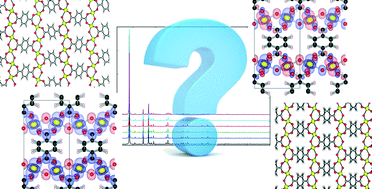Tag: CrystEngComm
-
Filed under Cover
-
November 13, 2015
| Authors: |
Thomas Bogaerts, Louis Vanduyfhuys, Danny E.P. Vanpoucke, Jelle Wieme, Michel Waroquier, Pascal Van Der Voort, and Veronique Van Speybroeck, |
| Journal: |
CrystEngComm. 17(45), 8565 (2015) |
| doi: |
10.1039/C5CE90198G |
| IF(2015): |
3.849 |
| export: |
bibtex |
| pdf: |
<CrystEngComm> |
The cover image depicts an X-ray beam hitting a sample of MIL-47(V) Metal-Organic Framework (reddish powder), resulting in an X-ray diffraction pattern. This leads to the atomic structure on the left, Where the spin-densities are indicated for the anti-ferromagnetic ground state. (The related paper can be found here.)

Permanent link to this article: https://dannyvanpoucke.be/paper2015_xrdthomasdannycover-en/
| Authors: |
Thomas Bogaerts, Louis Vanduyfhuys, Danny E. P. Vanpoucke, Jelle Wieme,
Michel Waroquier, Pascal van der Voort and Veronique van Speybroeck |
| Journal: |
Cryst. Eng. Comm. 17(45), 8612-8622 (2015) |
| doi: |
10.1039/c5ce01388g |
| IF(2015): |
3.849 |
| export: |
bibtex |
| pdf: |
<Cryst.Eng.Comm.> |
 |
| Graphical Abstract: Which model represents the experimental XRD-spectra best? Ferromagnetic or anti-ferromagnetic chains? With of without offset? |
The structural characterization of complex crystalline materials such as metal organic frameworks can prove a very difficult challenge both for experimentalists as for theoreticians. From theory, the flat potential energy surface of these highly flexible structures often leads to different geometries that are energetically very close to each other. In this work a distinction between various computationally determined structures is made by comparing experimental and theoretically derived X-ray diffractograms which are produced from the materials geometry. The presented approach allows to choose the most appropriate geometry of a MIL-47(V) MOF and even distinguish between different electronic configurations that induce small structural changes. Moreover the techniques presented here are used to verify the applicability of a newly developed force field for this material. The discussed methodology is of significant importance for modelling studies where accurate geometries are crucial, such as mechanical properties and adsorption of guest molecules.
Permanent link to this article: https://dannyvanpoucke.be/paper2015_xrd_crystendcomm-en/



